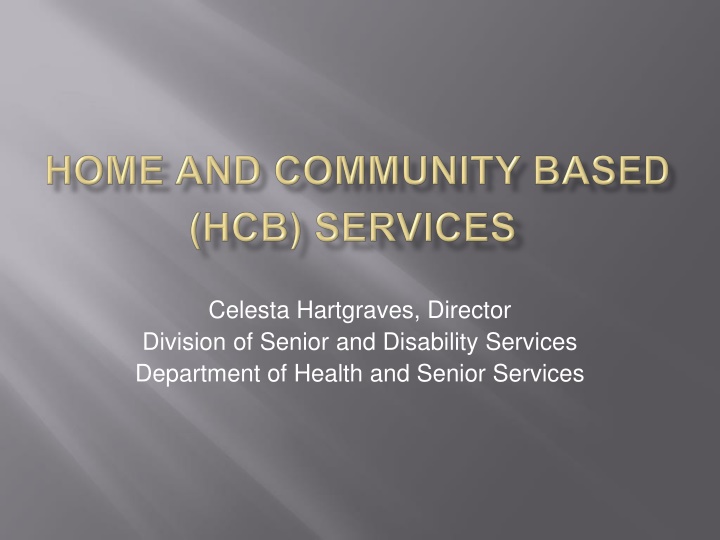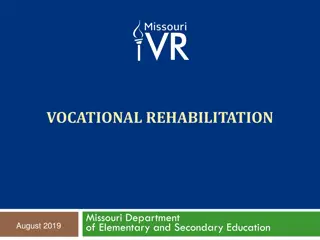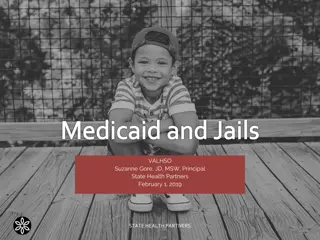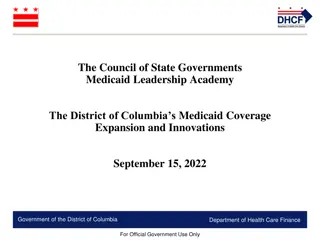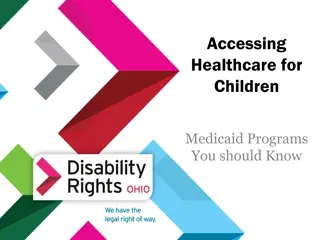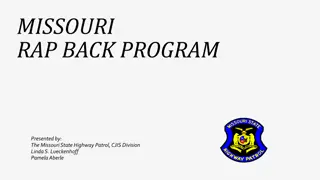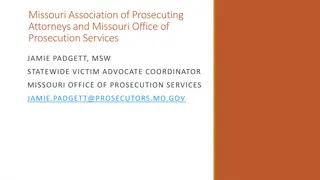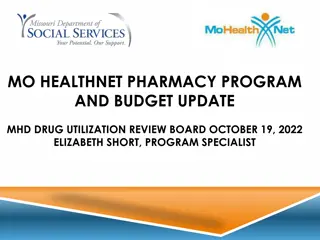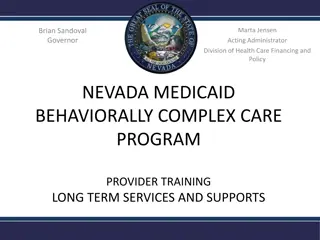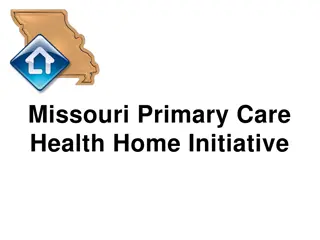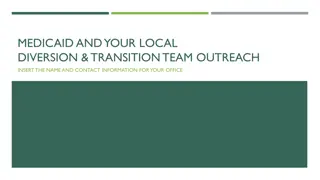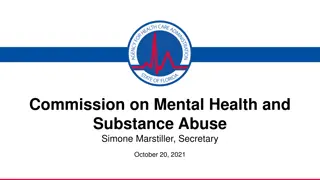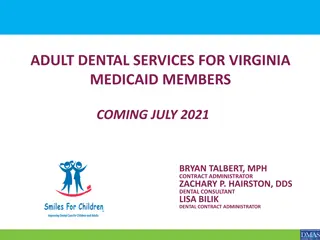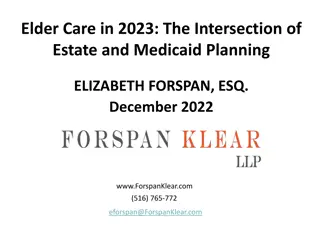Medicaid Program for Long-Term Care Services in Missouri
The Medicaid program administered by the Department of Health and Senior Services in Missouri provides long-term care services for elderly and disabled individuals. The program evaluates participants' needs based on a 21-point count to determine eligibility for nursing home or home and community-based services. Reassessments are conducted annually to ensure appropriate care. Medicaid-funded services are available through State Plan services and waivers, offering various models of care for those meeting specific criteria such as age, Medicaid status, and level of care required.
Download Presentation

Please find below an Image/Link to download the presentation.
The content on the website is provided AS IS for your information and personal use only. It may not be sold, licensed, or shared on other websites without obtaining consent from the author.If you encounter any issues during the download, it is possible that the publisher has removed the file from their server.
You are allowed to download the files provided on this website for personal or commercial use, subject to the condition that they are used lawfully. All files are the property of their respective owners.
The content on the website is provided AS IS for your information and personal use only. It may not be sold, licensed, or shared on other websites without obtaining consent from the author.
E N D
Presentation Transcript
Celesta Hartgraves, Director Division of Senior and Disability Services Department of Health and Senior Services
2011-2014 Projections are from the 2014 American Community Survey. Missouri Population Estimates 2011 2012 2013 2014 Age 65+ Age 18-64 and Disabled Total Missouri Population 854,604 884,325 908,358 931,890 449,310 454,722 465,901 478,963 6,010,688 6,021,988 6,044,171 6,063,589
What does this program do?
This core funding reimburses: Agencies providing in-home services; and Individual vendors performing consumer directed services.
The Department of Health and Senior Services (DHSS) is responsible for assessing Medicaid participants Level of Care (LOC) to determine if their needs meet a 21-point count, making them eligible for long- term care services under the Medicaid program. Those meeting the 21-point count qualify for nursing home or home and community-based services (HCBS). DHSS develops HCBS plans of care and makes changes to those plans as appropriate. DHSS manages and oversees annual reassessments of Medicaid participants currently participating in the HCBS program to ensure they remain eligible for such services and are receiving the appropriate level of services.
Medicaid funded HCBS are available through either State Plan services or through a Home and Community Based Waiver. In Missouri, these services are available through both options.
Personal Care Agency Model Personal Care Consumer Directed Model (CDS) Advanced Personal Care Residential Care Facility(RCF)/Assisted Living Facility(ALF) Personal Care Nurse Visits
At least 18 years of age In active Medicaid status Blind Pension may be authorized for personal care Meet nursing facility level of care
Dietary Dressing/Grooming Bathing Toileting/Continence Mobility/Transfer Self-administration of medication Medically necessary household tasks (rarely authorized in RCF/ALF)
Changing bags and hygiene around ostomy site Application of medicated lotions Passive range of motion Use of assistive device for transfers
Filling Insulin syringes weekly for diabetics Monitoring skin condition Nail Care
Initial Entry: 18-64 Be Physically Disabled Self-Direct Nursing Facility LOC Active Medicaid
Personal Care Assistance (CDS Model) Bathing Meal Preparation Dressing/Grooming Laundry Toileting Assistance Essential Transportation Cleaning Essential Correspondence
Financial Management Services Case Management Environmental Accessibility Adaptations Specialized Medical Equipment Specialized Medical Supplies
2014-2019 174 participants 600 Slots
63 or older Meet Nursing Facility LOC Active Medicaid
Homemaker Meals/Dishes Shopping/Errands Clean Essential Correspondence Laundry Trash Iron/Mend
Chore Short-term/Intermittent (Medically Necessary/Unmet Need) Wash walls and woodwork Air mattresses and bedding Clean closets, basements and attics Spray for Insects (over the counter) Shampoo rugs Rodent control (over the counter)
Respite Care Basic Respite Advanced Respite Care Nurse Respite Care Unit (15 min) or Block (9-12 hours) or Daily (17-24 hours) Unit (15 min) or Block (9-12 hours) Unit (15 min) or Block (9-12 hours)
Adult Day Care Home Delivered Meals
2013-2018 16,343 Participants 26,392 Slots
Initial Entry: 18-63 Medicaid Eligible Nursing Facility LOC
Adult Day Care (15 Minute Units) Limitations: 10 hours per day 5 days per week No more than 8 units per day of transportation to and from ADC facility
Not available to: Residential Care Facilities Assisted Living Facilities Individualized Supported Living Blind Pension
2016-2021 1,370 Participants 2,000 Slots Renewal Application Submitted
Statistics on Participants Number of Participants per Waiver Type 20000 16,343 15000 10000 1,370 5000 174 0 ADCW ADW ILW As of March 31, 2016
FY 2012 FY 2013 FY 2014 FY 2015 FY 2016 New Referrals Care Plan Changes 16,429* 20,886 21,779 26,294 23,796 29,891* 35,090 35,323 35,882 37,694 * This number is low due to transition to third party administrator.
MO Medicaid Long Term Services & Supports (LTSS) Participants Average Monthly MO Medicaid Participants (All eligibility categories) 70,000 64,569 63,983 62,297 61,651 60,000 50,000 40,000 30,000 23,413 24,145 24,429 23,320 20,000 10,000 FY 2013 Actual FY 2014 Actual FY 2015 Actual FY 2016 Projected Nursing Facilities Home and Community Based Services
$50,000 $40,000 $39,790 $38,160 $38,091 $37,584 $36,135 $30,000 $11,209 $20,000 $10,917 $10,525 $10,356 $8,930 $10,000 $0 FY 2012 FY 2013 FY 2014 FY 2015 FY 2016 Proj. Nursing Facility Residents Home and Community Based Participants
$1,000,000,000 $800,000,000 $600,000,000 GR FEDERAL $400,000,000 OTHER $200,000,000 TOTAL $0 FY 2013 Actual* FY 2014 Actual FY 2015 Actual FY 2016 Actual *Department of Social Services incurred $8,399,623 in federal expenditures for HCBS in FY 2013, $9,537,729 in FY 2014, $11,510,220 in FY15 and $685,453 in FY16.
Statistics on Participants Consumer Directed Services Participants vs. Agency Model Participants 43% CDS 27,617 PARTICIPANTS 37,229 PARTICIPANTS AGENCY MODEL 57% As of March 31, 2016
FY 2016 Proj. FY 2013 FY 2014 FY 2015 In-Home Clients 37,972 37,566 35,961 35,776 Consumer Directed Services Consumers 22,718 25,855 28,750 31,311 Individuals may appear in both counts
Home and Community Based Services FY 2013 FY 2014 FY 2015 FY 2016 Actual Actual Actual Projected In-Home Clients (IHS) * 37,972 37,566 35,961 35,776 Consumer Directed Services Consumers (CDS)* 22,718 25,855 28,750 31,311 Residential Care Facility Clients (RCF)* 6,660 6,431 6,375 6,275 Home and Community Based Providers/Vendors 1,080 1,204 1,294 1,480 * Client numbers based upon number of clients receiving services during fiscal year.
Providers and Vendors 600 500 400 In Home Services CDS 300 ADHC/ADC Waiver 200 RCF/ALF 100 0 FY 2012 FY 2013 FY 2014 FY 2015 FY 2016 YTD FY 2012 FY 2013 FY 2014 FY 2015 FY 2016 YTD In-Home Services 337 348 370 388 431 CDS 145 197 298 378 484 ADHC/ADC Waiver 89 102 113 113 117 RCF 449 433 423 415 448 Total 1,020 1,080 1,204 1,294 1,480
In 2010, SB 1007 and SB 842 modified section 660.023 & 208.909 RSMo. All providers and vendors shall have, maintain and use a telephone tracking system for the purpose of reporting and verifying the delivery of In-home and CDS as authorized by the department of Health and Senior Services, or its designee. The telephone tracking system shall be used to process payroll for employees and for submitting claims for reimbursement to the MO HealthNet Division.
The statutory requirement for using a telephone tracking system does not apply to providers of Personal Care in an Assisted Living Facility or Residential Care Facility (ALF/PC RCF) or Adult Day Care setting (ADCW). DSDS promulgated a regulation regarding this statutory requirement for HCBS Providers. Missouri 19 CSR 15-9 Electronic Visit Verification became effective on February 29, 2016.
The term Electronic Visit Verification (EVV) as defined in the regulation, includes telephone and computer-based systems, as well as other electronic technology which HCBS providers can utilize to meet the statutory requirements. In instances where a telephone or other electronic verification options are not available or accessible in the participant s home, or the participant refuses to allow the use of EVV, the vendor/provider must have documentation on file explaining the reason attendant is not using EVV.
